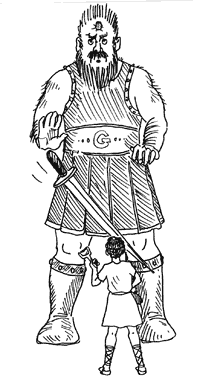STRANGE BUT TRUE- Stoned: David had physics on his side

DRAWING BY DEBORAH DERR McCLINTOCK
Q. In the classic Biblical confrontation, how did little David manage to defeat Goliath using just a sling? –G. Bush
A. For 40 days the giant Philistine had challenged the Israelis, but none had dared take up the fight until David stepped forth. He chose five smooth stones from a brook and walked into range, keeping safe because Goliath's sword was useless at such a wide separation, says Jearl Walker in The Flying Circus of Physics. David slung the first stone that hit with such momentum it burrowed into the giant's
forehead. The sling had a flexible pocket with two straps attached, made taut by pulling it in a vertical circle several times to build up kinetic energy. Then the knotted strap was released, sending the stone toward the target. The sling could hurl a stone of 25 grams (about 1 oz.) at 100 kilometers per hour (62 mph) to hit something 200 meters (656 ft.) or more away.
In some battles, the weapon proved more valuable than bow and arrow, for even if an enemy soldier wore leather armor, a stone could inflict lethal internal damage whereas an arrow might just be deflected. A sling was also more accurate and its projectile could travel farther. So the slingers were often grouped behind the archers, who needed to be closer to the enemy to be effective.
Q. Ever have roast pachyderm for dinner? Most people would turn up their noses, saying "I'm not into eating elephant." But are they so sure they've answered the question accurately? –J. Dean
A. More people should answer "yes" than you might imagine because the word "pachyderm" is not a synonym for elephant, says Mark Davidson in Right, Wrong and Risky: A Dictionary of Today's American English Usage. Coming from a Greek word for "thick-skinned," it refers equally to the elephant, rhinoceros, hippopotamus, tapir, and pig. Of course, many people would no more eat pork than they would elephant or rhino meat, based on cultural, health, or other considerations.
Q. Romance is one thing, but perhaps the most loving use to which human hair is put involves placing it in a hackle, a device for orienting all the strands side to side and weeding out those that are too short. The hair is then placed in a chemical bath to remove dyes, tints, etc. Bleached hair won't do as it disintegrates in the bath. Meanwhile a molded cap is made to size, and in go the hairs, 150,000 of them or about four ponytails' worth, at 10 inches or more each. That'll about do it. Do what? –S. Spaulding
A. Make a wig of donated human hairs, for use by patients who lose their hair medically, says University of Miami dermatologist Barry I. Resnik. Once the wig is in place, it can be styled to the patient's preference– loveliness in more ways than one.
Q. Billion-dollar brainteaser: Imagine Bill Gates toiling away in his cubicle one day when he spots a $100 bill lying on the floor. Would he be better off going "off the clock" for a few seconds to pick it up, or should he ignore the bill and just keep earning his "salary"? As a reference, consider the year his wealth increased by a reported $20 billion. –D. Trump
A. Assuming a 40-hour week for 50 weeks, Bill Gates' "secondly" income is $20,000,000,000 divided by 7,200,000, or about $2,800 every second, say Edward Burger and Michael Starbird in Coincidences, Chaos, and All That Math Jazz. Therefore every 1/28th second he earns another $100. "So not only should Mr. Gates not clock out to pick up the $100 bill, he shouldn't even stop to look at it."
Send Strange questions to brothers Bill and Rich at [email protected].
#